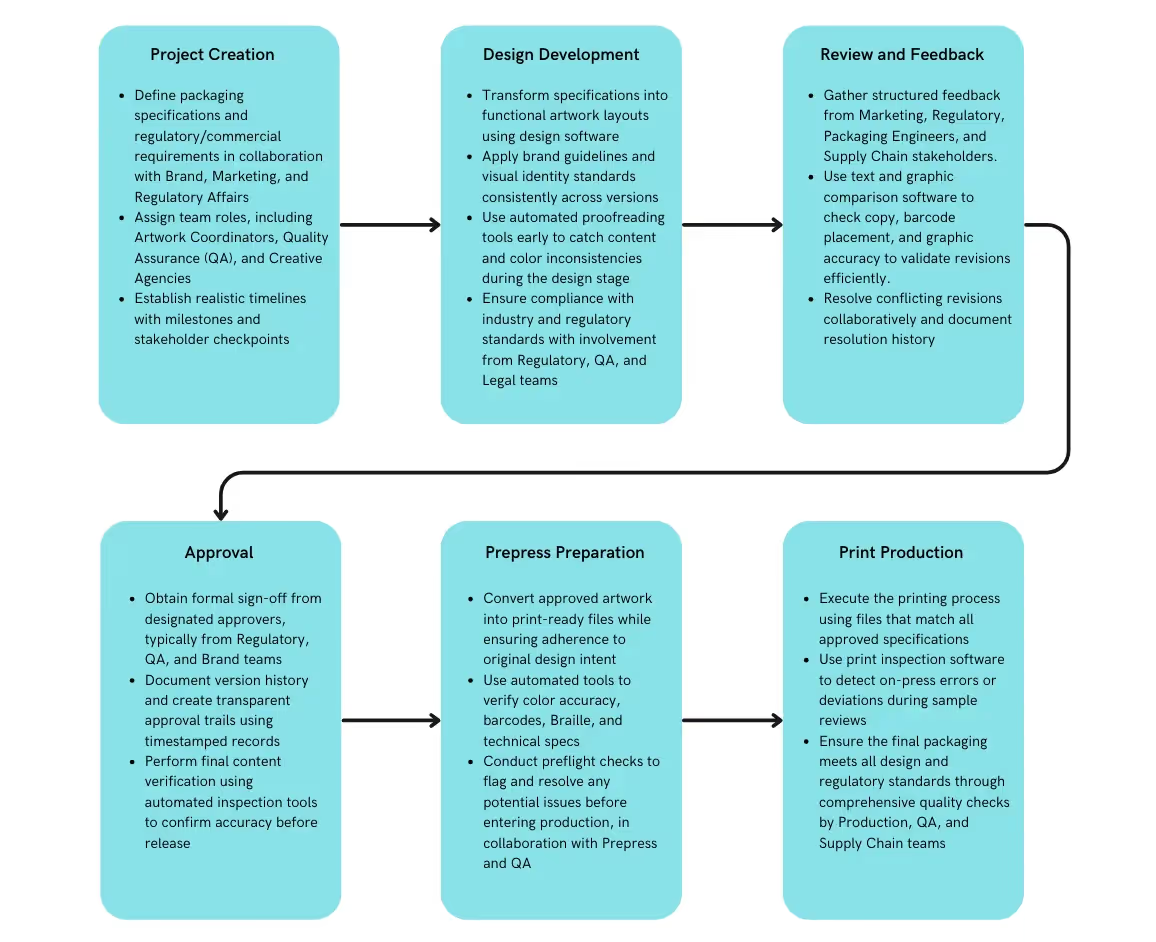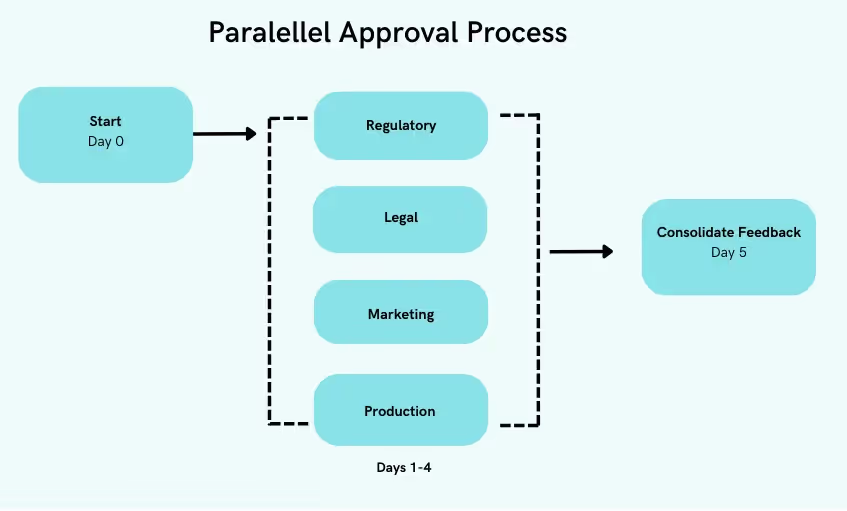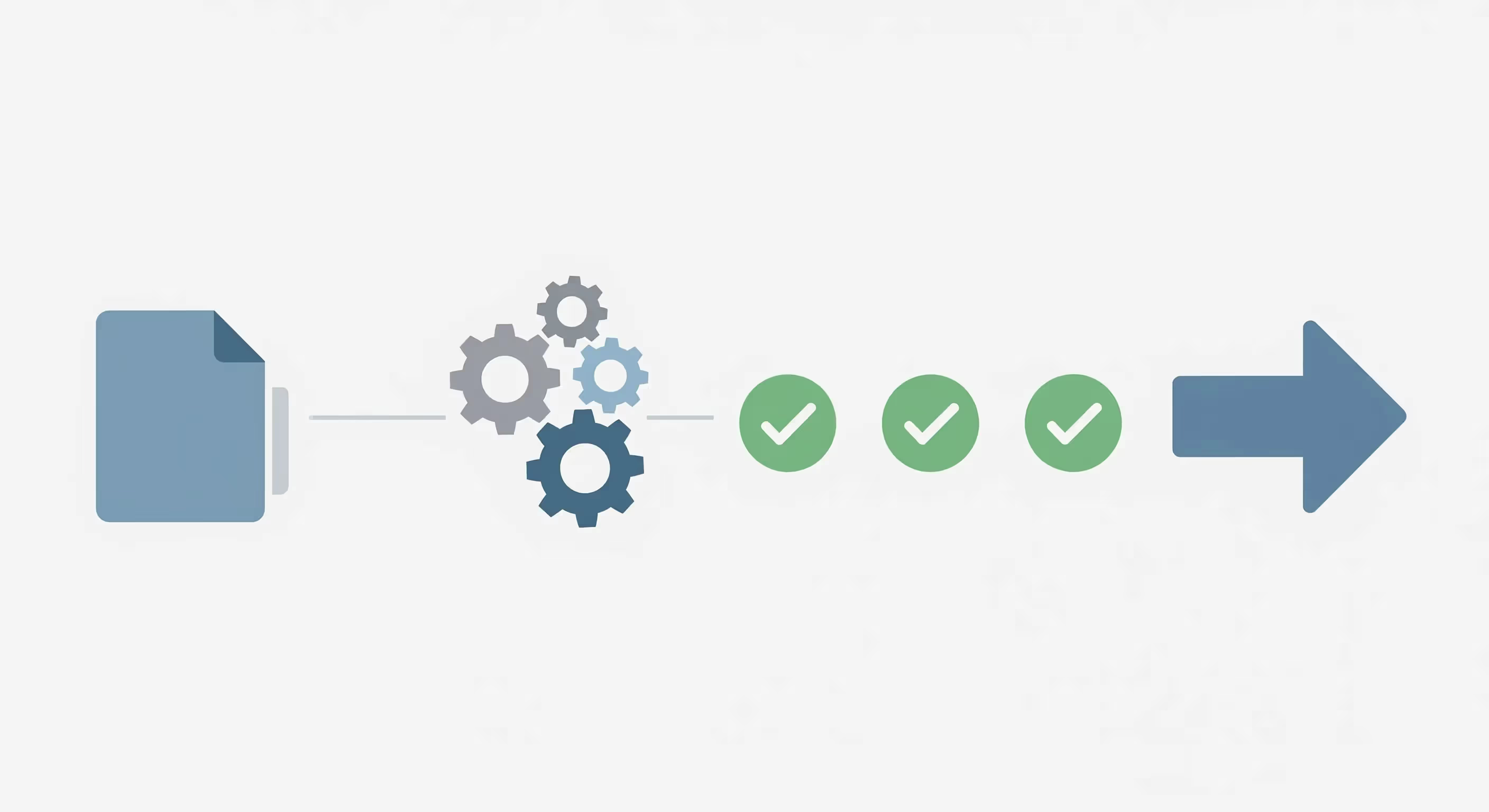Packaging accuracy directly impacts business success in regulated industries. An effective artwork management system creates measurable competitive advantages by reducing packaging errors, preventing costly recalls, and protecting brand reputation while accelerating time-to-market.
Understanding Artwork Management: Definition and Importance
Artwork management is the systematic process of creating, reviewing, approving, and storing packaging artwork assets. Proper artwork management ensures regulatory compliance, reducing costly errors and maintaining brand consistency.
The artwork lifecycle spans from concept through design iterations to final production. Without a structured approach, companies risk compliance violations and extended time-to-market that directly impact revenue.
The Complete Artwork Workflow Process
A packaging artwork process follows these essential stages:

Transitions between these stages create bottlenecks, particularly when feedback arrives late, or approval chains break down. Companies that master these handoffs gain a competitive advantage through faster market entry and fewer errors.
Why Effective Artwork Management Matters in 2025
Product launch delays from inefficient artwork processes steal weeks of time-in-market that directly impact bottom-line results. Packaging errors directly trigger product recalls, creating expenses far beyond the cost of reprinting materials. Digital tools have redefined artwork expectations - teams now demand real-time collaboration capabilities and enhanced collaboration across operations. For packaging managers, a thorough artwork approval solution has become critical to organizational success.
Key Components of a Successful Artwork Management System
Enterprise labeling and artwork management systems deliver value through several core components that work together:
- Centralized asset repository with version control
- Task management tools that increase accountability
- Detailed review capabilities for precise feedback
- Automated workflows that enforce approval sequences
- Integration with design software and production systems
Streamlining the Artwork Approval Process
Accelerating your artwork approval process starts with implementing parallel reviews rather than sequential approvals, while setting clear deadlines with automated reminders to prevent bottlenecks.


To further streamline the process, integrating automated proofing tools like Verify to detect errors in text and graphics allows companies to catch errors early when they're less expensive to fix.
Choosing the Right Artwork Management Solution for Your Business
Choosing the right solution prevents costly implementation mistakes and delays while maximizing ROI. When evaluating systems, focus on scalability, user experience, security and compliance features, integrations with your tech stack, and effective reporting.
Small teams might start with manual checks, but scaling requires purpose-built software. Quality control systems like Verify operate alongside artwork management solutions like Veeva Vault or Kallik Veraciti, catching errors after artwork creation, but before production.
The efficiency gains from automated artwork management solutions typically deliver positive ROI for businesses handling 50+ packaging projects annually, especially in regulated industries where errors carry higher costs.
Cloud-based solutions offer accessibility for distributed teams and reduce IT infrastructure costs, while on-premise options provide greater control over data security and compliance.
The impact is clear: Biogen saved $1.2 million and accelerated their artwork cycle by 12% after implementing GlobalVision Verify, transforming inefficient processes that once caused compliance issues into a streamlined workflow with fewer revision cycles.
Artwork Management Across Different Industries
Different sectors face different challenges. Pharmaceutical companies navigate stringent regulatory compliance requirements where accuracy directly impacts patient safety. Consumer packaged goods balance frequent marketing changes with brand consistency across product lines.
Large enterprises implement more complex approval hierarchies than smaller businesses, which typically prioritize flexibility and speed. Understanding industry-specific needs determines which artwork workflow systems will deliver competitive advantage.
Measuring ROI and Performance of Your Artwork Management Process
Tracking specific metrics proves the business impact of your artwork approval solution. Key performance indicators should include:
- Average approval cycle time
- Number of revision rounds per project
- On-time completion rate against production deadlines
- Error detection rates at each stage of review
- Team capacity and task load distribution
To deliver higher quality results faster, packaging managers must identify and eliminate unnecessary steps to focus team effort where it creates the most value.
Technology Trends Shaping Modern Artwork Management
There are three key trends transforming the artwork management landscape:
AI and machine learning detect errors human eyes miss, automatically flagging compliance issues and learning from each review to improve accuracy over time.
Cloud-based collaboration enables real-time review regardless of location, cutting approval times while maintaining security across internal and external teams, a top priority in regulated industries.
Digital asset management integration connects artwork approval directly to marketing operations, ensuring brand consistency through automated versioning and distribution.
Forward-thinking companies are transforming compliance processes into strategic advantages to accelerate time-to-market without sacrificing quality.
Best Practices for Implementing a New Artwork Management Process
Successful implementation of artwork management systems requires a structured approach:
- Pinpoint specific bottlenecks and create decisive approval paths
- Win executive buy-in before launching your pilot project
- Deliver role-specific training that builds immediate confidence
- Use automated reminders that keep projects on schedule
- Create clear escalation paths that prevent individual roadblocks
- Build confidence by temporarily running parallel processes during transition
A methodical implementation strategy reduces resistance to change and maximizes adoption across teams from design to regulatory to marketing.
Future of Artwork Management: What's Next
The most successful companies will leverage artwork solutions as compliance tools, but also as strategic assets that accelerate innovation while controlling risk. Organizations investing in these systems position themselves for competitive advantage, particularly as packaging complexity increases.
Enhanced automation will eliminate routine decision-making, freeing teams to focus on strategic elements. Stronger integration across the supply chain will improve visibility from concept to consumer.
Companies gaining market advantage won't just have the best products - they'll have mastered their packaging artwork processes. Smart investments today create the efficient workflows that drive faster launches tomorrow.



